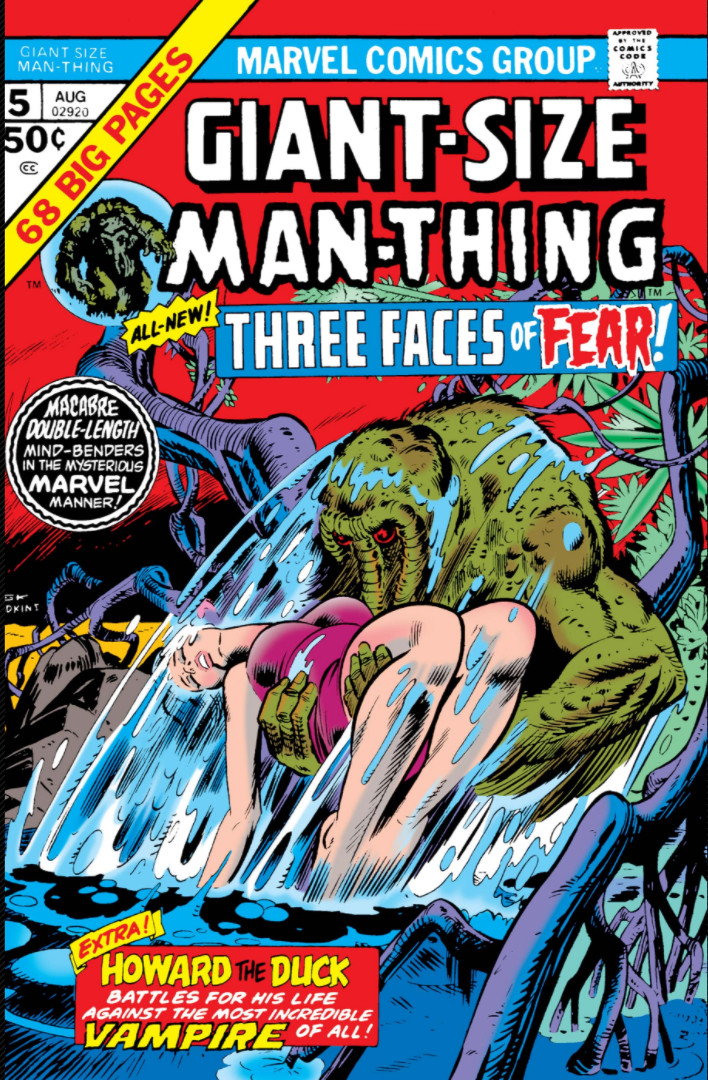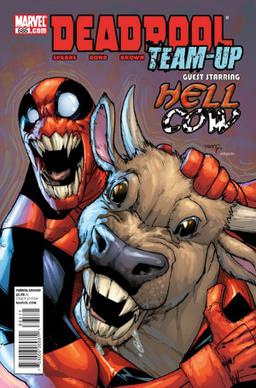The new forums will be named Coin Return (based on the most recent vote)! You can check on the status and timeline of the transition to the new forums here.
Please vote in the Forum Structure Poll. Polling will close at 2PM EST on January 21, 2025.
[Retrospective]Giant-Size Man-Thing #5
Bobby Derie Registered User regular
Registered User regular
 Registered User regular
Registered User regular

We often get caught up in the continuity of comics. Big events, the interconnections between different titles, the little things and the big things and the crossovers that give shape to the bigger universe, the bigger narrative that the comics take place in. Which is all good fun, and part of the thing that makes comics, particularly American-style comics, interesting. But we shouldn't forget the small things.
Man-Thing is an interesting b-list character in Marvel. He's pretty much a clone of DC's more well-known Swamp Thing, but that in itself is rather important: Man-Thing is not conceived as a superhero, or even a superhero comic. It's a monster comic, which was first published in an era when the Comics Code Authority was in charge and had largely clamped down on horror comics, neutering entire genres. As such, Man-Thing is a bit...out of place in Marvel. Most of the time, he's a mindless shambling hulk of plant matter with a gimmick ("All who know fear burn at the Man-Thing's touch.") and a laughably complicated backstory involving the Okefenokee Swamp, the Nexus of All Realities, an attempt to duplicate the Super Soldier Serum that empowered Captain America, and an ex-girlfriend. This highlights another aspect of the Man-Thing not everybody appreciates: because he's outside of the normal superhero milieu, he tends to show up in odd places and work with odd characters. He's a pretty solid backup in a lot of magical storylines involved Zhered-Na or Doctor Strange, for example, and they used to like to pop up a panel of him whenever something multidimensional and weird was going on. He still does that on occasion, and even today still gets roped into the occasional team-up...but I digress.
So this is a weird comic because it's a monster comic, not a superhero comic. It's also weird in format, because this particular issue is three short stories tied together with a framing device, plus two backup stories for a meaty 68 pages. The idea of a framing device for a bunch of mini-narratives is a very old and well-beloved trick - think of Scheherazade in the 1,001 Nights, or H. P. Lovecraft's "The Call of Cthulhu" - and it actually translates rather well to the comics milieu. Back before trade paperbacks were ubiquitous, many comics featured reprints of old stories - sometimes with a framing device, sometimes just as a backup feature - to fill an issue.
And we were grateful for it too, because back in the day if you wanted to know what happened when the characters referenced X, Y, or Z you either had to get a reprint, hunt out the obscure back issues, or result to some of the weirder tricks out there like the Official Handbook to the Marvel Universe or the issue-by-issue guides to the Avengers or some of the fan publications.
More importantly, I think, the idea of mini-narratives with a framing device was an important element of EC Comics' horror tales, which I think is probably the more direct influence here. So Ted Sallis (the future Man-Thing) is at a carnival and an old gypsy woman projects three future episodes for him - thus, her predictions become the framing device. The stories themselves are...meh. "There's A Party in 6G" involves swinging 70s occultists and a demon they've summoned; the best bit is probably the Man-Thing riding an elevator. It's one of those nice little details that you know DC would have fallen down on. Does Batman ride the elevator? Fuck no, Batman probably has a grapple-hook or something. But it's all the funnier for Man-Thing, because you have to remember that this is a character with literally no mind - so imagine if, I dunno, Krypto is incognito as a regular mutt and has to ride the elevator. I feel I'm overworking a minor point here, but I thought it was nice attention to detail.
Episode two is "The Sins of the Fathers." Teens are in love and run away into the Florida swamps...it's basically Romeo and Juliet set in the Florida everglades with a bunch of rednecks. The girl drowns and the boy offs himself with his dad's shotgun. The Man-Thing is barely in this story - he fishes the girl out of the quicksand after she drowns - but I think that highlights the difference between this book and a superhero book. The Man-Thing is not necessarily here to save your day. He's chill with just being a mute witness to teenage hormone-induced dumbassery and redneck swamp feuding. It is actually important, I think, that the comics guys can get away with this sort of thing every now and again - to broaden the edges of what is possible in comics, to show the readers that look: characters can die, we can make highbrow literary references that readers might respond to, and not every story has to have a happy ending. Happy endings are overrated in comics. Hell, in this day and age where one big event segues into the next, endings are almost a rarity.
The third episode is "Lifeline." A mercenary burned by the Man-Thing returns for revenge, with his own group of monster-hunters. Again, the Man-Thing isn't exactly the protagonist or hero - he's the subject of the story, because he's being hunted. Much like the Incredible Hulk in the early days. The soldiers corral him in and try to blow him up with conventional weapons, but the burn-faced guy gets a little too gun-happy and fires off some missiles that blow up his own men, so one of the surviving troops aims a missile at burned-faced guy...and at the end, it's just the unharmed Man-Thing and the one remaining soldier, and the Man-Thing walks off without even a shrug. See, there's no animosity in the Man-Thing - he's a blank slate. He only reflects the emotions that people direct toward him. Leave him the fuck along, and he's happy just wandering around the swamp. So again, this is a very atypical tale for a superhero comics universe. It's a Man-versus-Nature tale, dressed up as Man-versus-Man tale.
But of course, nobody cares about that. No, what this issue is much loved and remembered for is the backup feature...

Yes, it's "Hellcow!" With a cameo from Dracula (who is slumming from Tomb of Dracula, and starring of all people Howard the Duck, this has got to be one of my favorite - and most reprinted - horror shorts from Marvel comics of all time.
The story itself is almost childlishly simple and all the better for it. One night three hundred years ago, a thirsty vampire slakes his thirst on an ordinary bovine, transforming her into a demonic hellcow! (Complete with cape! I love the cape!) Smarter than your average cow, Bessie preys on lone farmers and travelers, posing as a lost cow. Again, it's the little details of this story, the fantastic characterization of a vampire cow that I love. Of course her udders are dry. It's so silly that it comes back around to brilliant.
Anyway, she runs into Howard the Duck, who quickly realizes what he's dealing with - and he puts her down with a tire-iron wielded like a cross (the image of Duck Jesus just slipped into my mind, but I'm sort of amazed that Bessie is Christian) and a handy hammer and stake.

Words sort of fail to describe the overall effect. It's the combination of the silly premise ruthlessly carried out in utter seriousness that really sells it; like I said, there is pathos in the image of a blood-drinking cow in a cape. Howard the Duck is locked in a life-or-death struggle with the undead milker! And the art is suitably fantastic, although it loses something with the colors.

And of course, that's not the end of Hellcow's story...

...but I digress.
The second and final back-up feature is "A Sight for Sore Eyes" - a reprint from an old 50s comic about a near-sighted burglar that steals a serum to cure near-sightedness and ends up turning into a bat-human hybrid. Like ya do. It's basically an ironic-punishment yarn, a relative of the conte cruel, similar to what a down-market Edgar Allan Poe or slumming M. R. James might have cooked up as a potboiler. Decent, and indicative of one of the big advantages that the Big Two used to have: a massive back catalog of stories they could reprint or recycle as needed. That sounds excessive in today's market, but it's important to remember. Look at great independent comics like Death Vigil today which struggle with schedule slip - because the writers/artists are struggling to balance life, paying work, and their highly-acclaimed-but-nobody-orders-the-damned-thing indie book. Back in the 60s and 70s, Marvel and DC's enviable back catalogs meant that they had no problem filling issues month after month, even if the writers or artists died or whatever. Now, granted, you can take that too far - as Warren did with it's horror magazines - but it's a nice trick if you can pull it off. And of course, nowadays Marvel and DC (and other long-runners like Dark Horse and Image) are digitizing their massive back catalogs and putting them online, and collecting them in trade editions, so they can continue to generate tidy profits from them.
The takeaway from all this? Comics aren't always about superheroes. Big events are fun, but so is diversity of stories. Vampire cows and talking ducks are awesome. And buy Death Vigil. Seriously. Dude needs your support.

+4